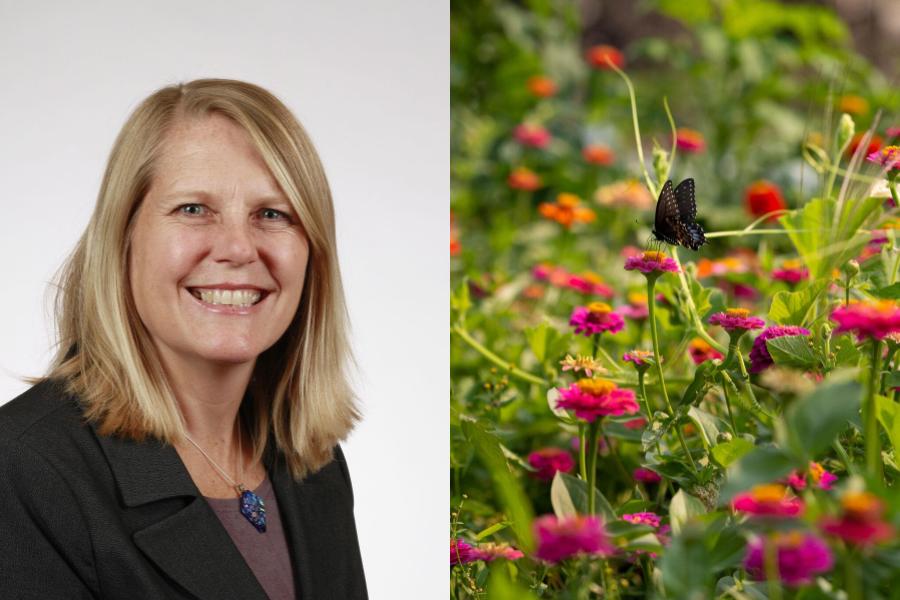
MINNEAPOLIS/ST. PAUL (05/12/2022) — Minnesota gardeners can’t be blamed for greeting May with more than the usual anticipation after April’s unrelenting cold, wet days.
Extension horticulture educator Julie Weisenhorn can relate, but she also says this is a good time to slow down and take stock of how choices made in our yards and gardens can have an impact on the environment in Minnesota and beyond.
Q: Can we really make a difference for the environment through our yards and gardens?
Absolutely. For example, you can conserve water by watering your lawn infrequently and deeply instead of sprinkling your lawn often. Deep and infrequent watering saturates soil and makes grass roots grow deeply, seeking that water and creating a healthy and resilient lawn. Plant diverse masses of pollinator friendly flowers, making sure something is blooming in your garden from April through October. Spring bulbs, summer perennials and annuals, and fall-blooming native flowers provide valuable and nutritious nectar and pollen for bees of all kinds who are in our landscapes early spring through late fall.
Q: Tell us more about why plant diversity matters.
There are all kinds of interactions between plants and animals, including insects. A monoculture of a particular plant only supports a small population with shelter and food. Certain plants have evolved with insects to support each other. For example, short-tongued bees forage on small flowers and pollinate the plant, and long-tongued bees feed on large flowers, pollinating as they forage. Monocultures of plants can intensify disease. Think of the majestic American elms that lined our city streets. Dutch elm disease (DED) moved from one tree to the next. Now we’re seeing the same with ash trees and emerald ash borer. So we stopped planting elms and now plant DED-resistant cultivars. Planting tomatoes every year in the same garden bed will perpetuate soil-borne diseases on tomatoes. The solution is to plant other plants in that soil - called “rotation” - that are not related to tomatoes and thus don’t keep perpetuating the diseases.
Q: How important is it for a gardener to understand their soil?
Think of soil as the foundation of every yard and garden. It’s important to have a good foundation because the soil will affect everything you do in your landscape now and into the future. Unless soil is toxic, we never recommend removing and replacing existing soil, but learning about it through a soil test and then amending it accordingly. Understanding your soil, along with the light and space you have to plant, is important when it comes to choosing plants that will thrive and not just survive.
Q: We can’t talk about yards and gardens without mentioning plant selection, right?
One of my favorite topics! There are so many great plants for Minnesota yards and gardens. As I mentioned, understand the kind of growing conditions you have available to you - soil, space size, amount of light - and then look for plants with growing requirements that match the site conditions. The "Plant Elements of Design" plant selection tool and video series is a good place to start, and will help us learn to consider the plant features we want and the site conditions we have before buying plants that may not be suitable. You can find it on our website, www.extension.umn.edu.
Q: What about people who don’t have a yard?
The good news is you don’t have to have a yard to have a garden. Patio, deck and balcony gardens can be a haven for us. Containers of all shapes, sizes and forms can be filled with diverse plants that feed us, protect us, smell great and attract and benefit bees, butterflies and even birds. And then there are houseplants! They can be moved outside in summer and then back indoors to bring the outside in during winter. There are basics to keeping pests from pestering your houseplants (and you) and ways to add supplemental lighting if your home lacks enough light.
The University of Minnesota Extension horticulture team regularly publishes ‘Yard and Garden News’ for free. You can also learn more at extension.umn.edu/yard-and-garden.
-30-
About “Talking...with U of M”
“Talking...with U of M” is a resource whereby University of Minnesota faculty answer questions on current and other topics of general interest. Feel free to republish this content. If you would like to schedule an interview with the faculty member or have topics you’d like the University of Minnesota to explore for future “Talking...with U of M,” please contact University Public Relations at [email protected].
- Categories:
- Agriculture and Environment





